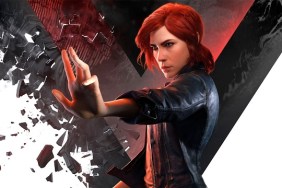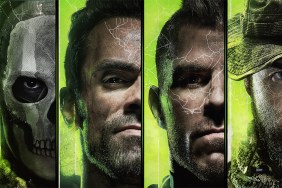You, Shanghai, January 12… and bring a friend.
As team-based and co-operative gaming increased in vogue, EA’s Army of Two placed the format front and center of its design. (Who knew the unwashed gamer masses would actually revel in playing together, rather than focusing on blowing each other’s virtual heads off… then doing unimaginable things to the bleeding corpse?). Amazingly for a brand-new IP, and one that averaged out around a mediocre 70-75% in its review scores (GR scored it a respectable ‘B’), Army of Two sold well… to the tune of some 2.6 million copies across formats according to some reports. That’s the kind of commercial performance that earns a second chance to build on the good and fix the bad. And with so many players, feedback from the community was fast, loud, and plentiful. (Mostly loud.)
[image1]Now, we have expectations of this explosive sequel, a situation not lost on Executive Producer Reid Schneider. We quizzed him about lessons learned, and how they will impact a newly refined co-operative gaming experience set in a deadly and destroyed Shanghai.
Game Revolution: What were the top few lessons or directions you learned from the original game about what works, what doesn’t, what players want and don’t want in a co-op action game?
Reid Schneider: I think the core of what we learned was that people wanted more variety and an increased focus in systemic AI. With the new game our goal was to be able to give the AI all the abilities that the players have, which equates to a greater sense of challenge. We also learned that more features do not necessarily make the game better. Rather, it’s about polishing the features and quality over quantity. With AO2:TFD we wanted to give the players a suite of organic co-op moves that could be used anywhere, as opposed to the first game where the moves would only work in certain situations.
Finally, we learned that things which a North American audience can find appealing can be really hard to swallow for our European players. Based on this we dramatically changed the tone of the game. We wanted people to be able to make choices about who they are in a disaster scenario when nobody is looking. This is fundamentally way more interesting as it’s all about player choice. In short, we took a lot of feedback to heart, and really tried to rework areas of the game that were not received well. At the same time we maintained the co-op focus 100%.
GR: If you’re Johnny NoMates and have to play solo, how have you approached bringing your partner to life?
RS: In this case we learned a lot from the first game as well. If you’re playing alone, we really want you to feel as if the partner AI is there to work hard alongside you. We also wanted to make sure he did not do anything that would break the illusion of intelligence. For example, now we make sure he never tries to drag/heal you in the line in the fire. We also now give the player the ability to give [your AI partner] more guidance and work with him like another real player. What I mean by this is that anything that is “interactive” can also be manipulated by the partner AI. The player just needs to aim his reticule over the object, tell the partner to interact with it, and he’ll do it. We’re pretty excited about the progress.
[image2]GR: How much was Left 4 Dead played at the office to spur development of Extraction mode?
RS: Let’s just say our guys are huge Left 4 Dead and Horde fans. With that in mind, we wanted to come up with a bonus mode that would give them an experience like that in the AO2 universe. Also, with Extraction we wanted to do something that had its own feel. Finally, we want the player to feel like he is conquering spaces and moving through a map.
GR: What enhancements to the experience can players expect if they played through the first game sat on a couch with a friend?
RS: It’s pretty interesting actually; when we shipped the first game we did not know split-screen co-op would be anywhere near as popular as it was. We often had pressure to cut it, but we wanted to keep it in there for local co-op play. In our after-market research, we found that a ton of people were playing the game in this manner.
With that in mind, we made a lot of adjustments to the split-screen co-op experience. The first is that the split in Campaign is now vertical as opposed to horizontal. The main reason for that is the new game has a lot of vertical space elements. We wanted players to be able to have a better view of the action. However, in Versus Mode the maps are generally more flat so we decided to have a traditional horizontal split-screen experience. Also, we have the ability to play split-screen versus mode against others (we support up to 12 players now), so they can enjoy the experience together and battle it out over PSN or Xbox Live.
GR: What made Shanghai the ideal setting for this conflict?
RS: We picked Shanghai because we thought it was a really iconic city. About eight years ago I was working at Ubisoft on the original Splinter Cell. A group of us were sent there to work with the Chinese team doing the PS2 version. I remember being completely blown away by the city. The mixture of skyscrapers next to extreme tenements was overwhelming. Also, the city’s skyline and an area they call the Bund, which is by the river, looks like nothing else in the world. Finally, we knew for the realism factor that focusing on one location (as opposed to globetrotting) gave the game a much more grounded feel. It was pretty much a combination of all these reasons which lead us to choose Shanghai.
[image3]GR: Given that Army of Two performed so well commercially, how did that impact your goals and ambitions for this sequel?
RS: We were really happy that the game performed so well commercially. At the core I think we struck a nerve with our customers, and created a game that gave players the opportunity to team up with a buddy and take on the world.
Also, we had the ability to go out and recruit some top talent to work with us on the new game. We had people join us from Insomniac, Maxis, LucasArts, Rainbow Six, Thief, etc. With the addition of these talented people we were to expand upon our vision of the sequel.
GR: Any advances in the positive and negative emotes in communicating with your buddy?
RS: It’s funny, this was an optional feature in the first game, and also probably the one that was most talked about. In the new game the more you negatively or positively emote with your partner the more it changes your Camaraderie index. We use this to measure how your partnership is tracking. This is clearly displayed in the game but then also pushed to the AO2 website. The new AO2 website is really robust in terms of stat tracking. We think people will really like it.











